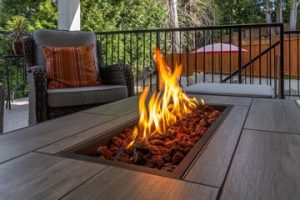
Seasoned Wood
Seasoned wood is a great choice for fire pit fuel. This type of wood has been dried out, typically over several months, and contains very low levels of moisture. As a result, it produces less smoke when compared to green or unseasoned wood. Burning seasoned wood also offers more heat production and longer burn times per log than what you would get from using wetter logs in your fire pit. In addition to being easier on your lungs, this type of fuel also helps reduce the risk of flare-ups that can require extra attention during use.

Propane
The burning of propane is often considered to be a safer option than wood fires when it comes to firepits. Propane flames are contained and the fuel itself is more contained in tanks, making them easier to transport. Additionally, propane burns much cleaner than wood, with less smoke and soot being released into the air — meaning fewer particles of ash will remain on clothes or furniture nearby. On the downside, propane can be significantly more expensive than other fuels such as natural gas or wood due to its higher energy density.
Natural Gas
Natural gas is a popular option. It’s odorless and produces an even flame that can be controlled with the turn of a knob. Plus, you don’t have to worry about running out of logs or charcoal in the middle of your evening by the fire – just make sure you check your tank levels! Natural gas is also convenient because it doesn’t produce smoke or soot as burning wood does. You can enjoy a clean-burning fire without having ashes to clean up afterward.
However, there are some drawbacks to using natural gas as fuel for your outdoor fire pit. For one thing, depending on where you live and how far away from a natural gas line you are may mean that you need to install a propane tank to use natural gas. This can be expensive and may require a professional installation. Additionally, although natural gas is more efficient than burning wood, it will still cost you money for fuel. Natural gas fire pits are also not ideal for camping or picnicking where there isn’t an easy access point to natural gas lines. In these cases, using traditional fire pit fuel such as charcoal or logs may be your best option.
Bio-Ethanol
Bioethanol is a renewable source of fuel and has become increasingly popular for use in fire pits. It is clean, odorless, and environmentally friendly compared to other types of fuels such as gas or wood. With bio-ethanol, the only byproduct is water vapor and carbon dioxide making it an ideal choice for those looking to reduce their emissions. The convenience factor also makes this fuel attractive, since you don’t have to constantly purchase logs or refuel your tank with gasoline when using bio-ethanol. Additionally, with bio-ethanol, there are no smokey smells that can linger around your home or patio area due to its clean-burning properties.
On the downside, bio-ethanol does not provide long-lasting heat due to its low energy content. This means that you will need to constantly monitor and refuel your fire pit as the fuel burns off quickly. In addition, bio-ethanol is more expensive than other fuels such as wood or gas, so it may not be a viable option for those on a budget. Finally, bio-ethanol is also sensitive to extreme temperatures and direct sunlight which can reduce its effectiveness when used outdoors.
Gel Fuel

One major advantage of gel fuels is their convenience—they don’t require any kind of setup or cleanup, so they’re perfect if you just want to enjoy a quick fire without any fuss. Additionally, because the flames burn cleanly and efficiently with no smoke or sparks, they can be used safely indoors as well as outdoors. Furthermore, since the flames do not produce any heat beyond the immediate area around them, they are ideally suited for small spaces like balconies or patios.
However, there are some drawbacks to using gel fuel for your fire pit. While it does burn cleanly and efficiently, the flames tend to be lower than those of a wood-burning fire pit—and they don’t last as long either. Additionally, since gel fuels are relatively new technology, their cost can be quite high compared to more traditional fuels such as wood or gas. Finally, depending on the type of gel fuel you choose, they may require special containers that can add additional cost and complexity to your setup.
Charcoal
Charcoal is an attractive fuel source for a fire pit because it produces less smoke than wood. It also takes up less space in your fire pit, meaning that you can fit more of it onto your cooking grate. Additionally, charcoal lights quickly and reaches its maximum heat output quicker than wood does. However, charcoal comes with some drawbacks as well. For one thing, it can be more expensive to buy if you don’t have access to natural sources like fallen tree branches or cut logs from a nearby sawmill.
What Type Of Fire Pit Fuel Is Best For You?
Yes, pavers do need to be leveled. They should be level in two directions – horizontally and vertically. Horizontal leveling is required for even contact with the base material, while vertical leveling ensures that there are no gaps between adjacent pavers that could trap water or debris.
Choosing the right fuel for your fire pit is an important decision. You want to make sure that you are selecting a type of fuel that will be safe and provide maximum enjoyment for those gathered around it. Here are some tips to consider when selecting a fuel source:
First, take into account the size of the fire you wish to create. Different fuels have different heat outputs, so this could impact how large or small your fire needs to be to maintain safety and comfort. Another factor is cost: certain types of fuels may be more expensive than others, so it’s important to consider your budget before making a selection.
In addition, think about convenience when deciding on a fuel source for your fire pit. Many types of fuels require specific preparation and/or storage methods, which could become a hassle if you are not prepared for them. Finally, it is important to consider the environmental impact of your fuel choice. Some options may create more smoke or release pollutants into the air, so be sure to research each type thoroughly before committing to a particular one.
By taking all these factors into account when selecting an appropriate fire pit fuel source, you can ensure that everyone in your group will have a safe and enjoyable experience around the fire!
What Amount Of Heat Is Produced By The Fuel?
The amount of heat produced will depend on a few factors. One factor is the type of fuel being used. For example, natural gas produces less heat than propane, and wood produces more heat than other types of fuel. Additionally, the size and shape of the fire pit can affect how much heat is generated by each type of fuel as larger pits need more fuel to generate enough heat for a long-lasting flame. The duration in which you plan to use your fire pit also affects how much heat is produced; longer burn times typically require more fuel to achieve maximum output.
How Long Do You Want Your Fire Pit Fuel To Burn?
Choosing the right fuel for your fire pit can make a big difference in how long it will burn, and what kind of experience you’ll have. If you want an efficient, long-burning flame that doesn’t require constant refueling, then choosing the right type of fuel is essential. There are several options available when selecting fire pit fuel: wood logs, charcoal briquettes, or propane tanks. Each has its advantages and disadvantages when considering factors such as cost, convenience, and environmental impact.
Wood logs are perhaps the most traditional and cost-effective form of fire pit fuel but they usually require more maintenance than other types to ensure they stay lit properly. Charcoal briquettes are also relatively inexpensive and can burn for a long time, but they tend to produce more smoke than wood logs. Propane tanks are the most convenient form of fuel as they require no maintenance or cleanup once lit; however, this convenience comes at a cost with propane tanks usually being more expensive than the other options.
No matter what kind of fuel you choose for your fire pit, determining how long it should be allowed to burn is important. Factors such as wind speed and humidity levels can affect how quickly the fire will consume its fuel supply so it’s best to limit burning times accordingly. Additionally, proper ventilation is essential when using any type of combustible material in an enclosed area like a fire pit – make sure there is adequate airflow around the fire to prevent the buildup of fumes.
We specialize in different types of brick pavers, from walkways to patios and fire pits. We can also provide you with the necessary materials for your project, such as sand and sealers. Our experienced team will help guide you through the entire process, from start to finish. Call us today at Palm Beach at 561-248-2509 or Treasure Coast at 772-242-0129 for more information!







